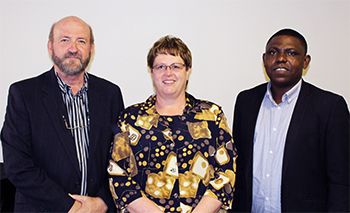
The Steering Committee of the Collaborative
Consortium for Broadening the Food Base comprises,
from the left: Prof Wijnand Swart (UFS),
Dr Sonja Venter (ARC) and Dr Eric Amonsou (DUT).
Photo: Andrè Grobler
There is huge pressure on the agricultural industry in southern Africa to avert growing food insecurity. One of the ways to address this is to broaden the food base on the subcontinent via crop production. Climate change, urbanisation, population growth, pests and diseases continually hamper efforts to alleviate food insecurity. Furthermore, our dependence on a few staple crops such as maize, wheat, potatoes, and sunflower, serve to exacerbate food insecurity.
Broadening the food base
To address broadening the food base in southern Africa, scientists from the University of the Free State (UFS), the Durban University of Technology (DUT) and the Agricultural Research Council (ARC) have formed a Collaborative Consortium for the development of underutilised crops by focusing on certain indigenous and exotic crops. The Consortium met at the UFS this week for two days (6, 7 March 2017) to present and discuss their research results. The Principal Investigator of the Consortium, Prof Wijnand Swart of the Department of Plant Sciences in the Faculty of Natural and Agricultural Sciences, said awareness had risen for the need to rescue and improve the use of orphan crops that were up to now, for the most part, left aside by research, technological development, and marketing systems.
"Many indigenous southern African
plant grains, vegetables and tubers
have the potential to provide a variety
of diets and broaden the household
food base.”
Traditional crops Generally referred to as alternative, traditional or niche crops, five crops are being targeted by the Consortium, namely, two grain legumes, (Bambara groundnut and cowpea), amaranthus (leaf vegetable), cactus pear or prickly pear and amadumbe (a potato-like tuber). Swart said these five crops would play an important role in addressing the food and agricultural challenges of the future. “Many indigenous southern African plant grains, vegetables and tubers have the potential to provide a variety of diets and broaden the household food base.” The potential of the many so-called underutilised crops lies not only in their hardiness and nutritional value but in their versatility of utilisation. "It may be that they contain nutrients that can be explored to meet the demand for functional foods," said Swart.
Scientific institutions working together
The Collaborative Consortium between the three scientific institutions is conducting multi-disciplinary research to develop crop value chains for the five underutilised crops mentioned above. The UFS and ARC are mainly involved in looking at production technologies for managing crop environments and genetic technologies for crop improvement. The DUT is focusing on innovative products development and market development.